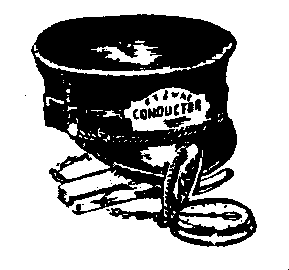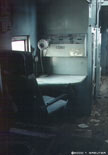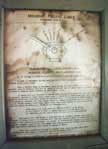This website has been archived from TrainWeb.org/screamingeagle to TrainWeb.US/screamingeagle.
|
||||||
| HOME Power Cabooses Rolling Stock MoW Depots | ||||||
|
Eventually we hope to compile stories as told by former employees of the Missouri Pacific, photos inside the "office on rails", caboose slang, and any other interesting information we come across. Enjoy! |
|
Conductor/Brakeman: the eyes & ears for the engineer during backward movements. Traditionally, the Conductor who walked up and down the aisles of the passenger cars taking tickets, etc. Flagman - Usually, the brakeman assigned to duties at the rear end of the train. To be a Flagman, the brakeman had to know how to read (so he could understand train orders), which from time to time would be changed enroute. For many years freight trains were operated by train crews consisting of at least four men: a conductor, a brakeman, a locomotive engineer and a fireman. The brakeman was the conductor's assistant. Every conductor had served his apprenticeship as a brakeman.
Big C, The Brains, King Pin, Skipper, Ram-rod, Conducer - more names for t he Conductor. Brakie, Pinner, Pinhead, Baby lifter - more names for the Brakeman. Swing - A brakeman who has responsibility for breaking up the train by setting out cars or sections of cars in the center position of a freight train. Crows
Nest - The cupola or box-like structure raised above the roof of a
caboose from which a trainman may see along the train while it is in motion.
Spotting Cars - Switching freight cars to a specified location for loading and unloading. Waybill - A document for handling and accounting for a shipment of freight. Way Car - A box car (or caboose) from which LCL shipments are loaded and unloaded at various towns. |
|
Nicnames Caboose - hack, crummie, brain box, cabeese (plural for "caboose"). The term "Caboose" is the best known name to describe any car attached to the rear end of a freight train for use by the train crew. The word "caboose" itself may have derived from the older term of "cabin." Called
a Short Bay Caboose (a shortbodied w/ platform-type caboose, used in road
service) by the MoPac, those that pulled and rode in them simply referred
to them as "doghouse cabooses", a term that stuck to this style like glue.
Despite appearing to be lighter than more traditional way cars, they actually
offered a pretty good ride. A DODGER caboose is one assigned to local service, something of a "southern" term. A dodger is another word for a local freight. Since it has the lowest priority of anything on the line; it dodges into the available siding whenever the dispatcher gives the word. |
|
The
C&EI War Wagons In
the Chicago area owing to some problems with a few of the neighbors and
a Conductor getting robbed while his train was stopped at 40th Street
in Chicago when the headend crew was making a set out, two of the cabooses
assigned to Yard Center received major modifications. |
 |
|
Houston,
Texas; date unknown - © Brian Paul Ehni photo
|
|
From
the Conductor's Office on Rails
Doghouse, cabin, hack, crummie... but most popularly known as the Caboose (the word "caboose" itself may have derived from the older term of "cabin"). It is the train crew's office on rails, and home while they are on the road. It handles the business-side of the transportation of merchandise -- The conductor keeps a complete record of all transportation produced and sold, each carload or less-than-carload shipment handled by the train, freight charges, the contents of each car, and weight of materials, the shipper, the station at which it was received, the station at which it is to be unloaded or left, and to whom it is consigned. The caboose is equipped with a table, a drinking-water cooler, benches/beds and chairs, a washstand and lighting. Modern cars made use of a wheel-mounted electric generator to produce electricity and charge the batteries. An oil stove (older cars used coal) provides heat in winter and for warming the crew's food at meal time. The cupola atop the car is the "watch tower" of the train. When the train is running, the conductor or one of the brakemen usually sits in the tower and watches in both directions to see that the train is running satisfactorily and that nothing is approaching from the rear. The lockers are provided for members of the crew and for the necessary flags, lanterns, light repair tools, oils and other supplies. On the older wood
cabooses there were brackets on the corners of the car hold signal lights
when the caboose is attached to a train. Modern steel cars replaced
these with electric marker lights |
|
Caboose Stories Related Links: |
|
KO&G 1529 short caboose This caboose was a very short car with a VERY short wheel base. Back when the MP (via TP) assumed control of the MV/KOG, this caboose was assigned to the Kirkwood local. A jobs conductor had been complaining about the condition of his 700 series wood caboose and as a result this car was assigned to his train. After a few trips banging down the track, he wanted his wood hack back. (B. Hoss) |
| Cupola | |||||
|
|||||
|
|
||||
|
|||||
| Bay Window | |||||
|
|
||||
| Power & Radio System | |||
|
|||
Before the introduction of the 13000 -series numbering system to the caboose fleet, cars that were radio equipped had an -R suffix added to the number. After the new numbering series, a simple white dot was placed above the car's number on the side of the cupola or body. |
|||
 |
MP 13689 - International Car Co. builder's plate from long bay window caboose - T. Greuter Photo |
 |
|
Short
Line Junction, Iowa. 8/13/97 - photo © RailArc
|
![]()
This Site is Dedicated to those who ran the MoPac
and made her one of the greatest roads in the Nation.
|
MPRR
Employee Feature Pages
- Input from all former-MPRR Employees welcome!
|
||||
Special Thanks to All the Former Missouri Pacific
RR Engineers and Employees
who have contributed their lives to the Railroad and their unique knowledge
to this site:
James Blagg MPRR Telegrapher-clerk, Concordia and Omaha Sub's, 1973-1987
Bob Currie MPRR Engineer DeQuincy Division, 1972-1990 (engineer 1973-1990)
Daryl W. Favignano MPRR Mechanical Engineering Dept. at St Louis, 1974-1986
Jay Glenewinkel MPRR/UPRR Crew Van Driver, 1992-1997
Nathan Griffin MPRR/UPRR, Hoskins Junction, Clute, Texas, 1975-Today
JD "Tuch" Santucci MPRR Engineer, Dolton and Villa Grove, IL , 1978-1985
Recommended Websites operated by former MPRR Employees:
Bob Currie's MISSOURI PACIFIC DeQuincy Division - MP Engineer
Hot
Times on the High Iron by "Tuch" Santucci - MP Engineer
Missouri
Pacific Railroad Memories by C.E. "Cliff" Satterfield - MP Superintendent
B.M.W.E.
Union, Lodge # 0455/Missouri Pacific System Federation
|
MPRR Employees Service Forum - Devoted to sharing information of former MoPac employees. Feel free to post names or information of those who worked on the railroad -- former MP Employees are Welcome! |
Help Save Lives
Operation
Lifesaver
The Ultimate Railroad Clip Art Library
|
trainweb.us/screamingeagle l Last Update
to this page: 16 April, 2008
|
|
| All images & text © 2000-2008 T. Greuter / Screaming Eagles, unless otherwise noted. All Rights Reserved. | |











 From
Inside the Cupola -
From
Inside the Cupola -  The
Job
The
Job 













